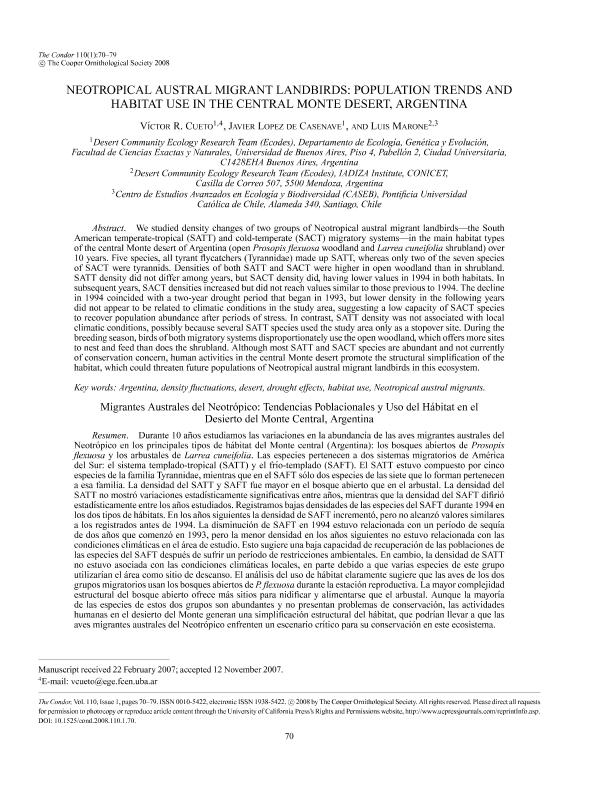Mostrar el registro sencillo del ítem
dc.contributor.author
Cueto, Víctor

dc.contributor.author
Lopez de Casenave, Javier Nestor

dc.contributor.author
Marone, Luis

dc.date.available
2020-03-04T20:31:58Z
dc.date.issued
2008-12
dc.identifier.citation
Cueto, Víctor; Lopez de Casenave, Javier Nestor; Marone, Luis; Neotropical austral migrant landbirds: Population trends and habitat use in the Central Monte Desert, Argentina; Oxford University Press; The Condor; 110; 1; 12-2008; 70-79
dc.identifier.issn
0010-5422
dc.identifier.uri
http://hdl.handle.net/11336/98805
dc.description.abstract
We studied density changes of two groups of Neotropical austral migrant landbirds - the South American temperate-tropical (SATT) and cold-temperate (SACT) migratory systems - in the main habitat types of the central Monte desert of Argentina (open Prosopis flexuosa woodland and Larrea cuneifolia shrubland) over 10 years. Five species, all tyrant flycatchers (Tyrannidae) made up SATT, whereas only two of the seven species of SACT were tyrannids. Densities of both SATT and SACT were higher in open woodland than in shrubland. SATT density did not differ among years, but SACT density did, having lower values in 1994 in both habitats. In subsequent years, SACT densities increased but did not reach values similar to those previous to 1994. The decline in 1994 coincided with a two-year drought period that began in 1993, but lower density in the following years did not appear to be related to climatic conditions in the study area, suggesting a low capacity of SACT species to recover population abundance after periods of stress. In contrast, SATT density was not associated with local climatic conditions, possibly because several SATT species used the study area only as a stopover site. During the breeding season, birds of both migratory systems disproportionately use the open woodland, which offers more sites to nest and feed than does the shrubland. Although most SATT and SACT species are abundant and not currently of conservation concern, human activities in the central Monte desert promote the structural simplification of the habitat, which could threaten future populations of Neotropical austral migrant landbirds in this ecosystem.
dc.format
application/pdf
dc.language.iso
eng
dc.publisher
Oxford University Press

dc.rights
info:eu-repo/semantics/openAccess
dc.rights.uri
https://creativecommons.org/licenses/by-nc-sa/2.5/ar/
dc.subject
BUFF-BREASTED SANDPIPER
dc.subject
MIGRATION
dc.subject
SHOREBIRDS
dc.subject
STOPOVER
dc.subject
TRYNGITES SUBRUFICOLLIS
dc.subject.classification
Ecología

dc.subject.classification
Ciencias Biológicas

dc.subject.classification
CIENCIAS NATURALES Y EXACTAS

dc.title
Neotropical austral migrant landbirds: Population trends and habitat use in the Central Monte Desert, Argentina
dc.type
info:eu-repo/semantics/article
dc.type
info:ar-repo/semantics/artículo
dc.type
info:eu-repo/semantics/publishedVersion
dc.date.updated
2019-10-10T19:33:15Z
dc.journal.volume
110
dc.journal.number
1
dc.journal.pagination
70-79
dc.journal.pais
Reino Unido

dc.journal.ciudad
Oxford
dc.description.fil
Fil: Cueto, Víctor. Consejo Nacional de Investigaciones Científicas y Técnicas; Argentina. Universidad de Buenos Aires. Facultad de Ciencias Exactas y Naturales. Departamento de Ecología, Genética y Evolución. Grupo de Investigación en Ecología de Comunidades del Desierto; Argentina
dc.description.fil
Fil: Lopez de Casenave, Javier Nestor. Universidad de Buenos Aires. Facultad de Ciencias Exactas y Naturales. Departamento de Ecología, Genética y Evolución. Grupo de Investigación en Ecología de Comunidades del Desierto; Argentina
dc.description.fil
Fil: Marone, Luis. Consejo Nacional de Investigaciones Científicas y Técnicas. Centro Científico Tecnológico Conicet - Mendoza. Instituto Argentino de Investigaciones de las Zonas Áridas. Provincia de Mendoza. Instituto Argentino de Investigaciones de las Zonas Áridas. Universidad Nacional de Cuyo. Instituto Argentino de Investigaciones de las Zonas Áridas; Argentina. Pontificia Universidad Católica de Chile; Chile
dc.journal.title
The Condor

dc.relation.alternativeid
info:eu-repo/semantics/altIdentifier/doi/https://doi.org/10.1525/cond.2008.110.1.70
dc.relation.alternativeid
info:eu-repo/semantics/altIdentifier/url/https://academic.oup.com/condor/article/110/1/70/5152333
Archivos asociados
